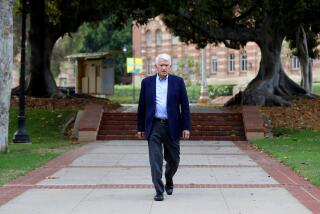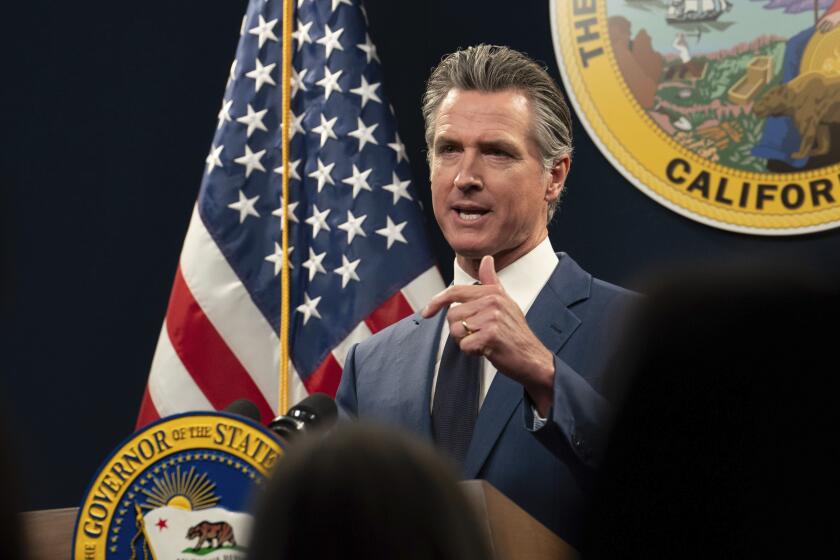Secession Means Nada
Latino activists take a relaxed, even smug, view of the San Fernando Valley’s effort to secede from Los Angeles, and with good reason. They know the demographic future of the urban sprawl on both sides of the Santa Monica Mountains is Latino.
Despite its outdated image as a largely white suburb, 42% of the Valley’s population in the 2000 census was Latino. That makes Latinos the largest ethnic group in the proposed new city--something they’ve been in Los Angeles as a whole for years.
In a deliciously ironic twist, the easygoing Latino view of secession has turned a detestable old stereotype on its head, making it a sign of growing political clout. Most Latinos don’t worry about secession that much because--whatever happens--there’s always manana.
Last week, we got an uninspiring preview of the overblown rhetoric likely to be heard in coming months when the Local Agency Formation Commission voted to put Valley secession on the November ballot.
LAFCO is the agency charged with researching the viability of proposed new government entities. Not surprisingly, it concluded that a Valley city with a population of more than 1.3million people has the potential to be economically viable.
The agency still must vote on similar proposals from residents of Hollywood and the harbor area. But the political battle was in full fury at Wednesday’s LAFCO hearing, and neither side came off very well.
That is why it is reassuring to note how the city’s Latino political leadership has been admirably restrained in pondering the ramifications of secession. Activist groups that have been criticized in the past for using harsh rhetoric or dire predictions of calamity to push for political change used a refreshingly different tack.
The Latino Redistricting Coalition and the Mexican American Political Assn. came forward with well-researched suggestions for making LAFCO’s secession plan fairer to the fast-growing Latino population in the East Valley.
Rather than two City Council districts with a significant number of Latino voters, as originally proposed, MAPA and the redistricting coalition persuaded LAFCO to draw a new map with four of the Valley’s proposed 14 City Council districts made up of at least 40% Latino voters. And a fifth will probably pass that milestone in a few years.
Combine that Latino-friendly map with the likelihood that popular elected officials from the Valley, such as state Sen. Richard Alarcon (D-Van Nuys) and Assemblyman Tony Cardenas (D-Mission Hills), may run for office in a new Valley city and it is easy to see why Latino activists are sanguine about the future of Latino political empowerment, no matter what L.A.’s future is.
Even on the city’s Eastside, where one might expect Latino activists to be concerned about the citywide impact of losing new Latino voters in places like Sylmar and North Hollywood, the prospect of Valley secession is seen more as an opportunity than a threat.
If the Valley leaves L.A., longtime activists on the Eastside say they may revive long-dormant plans to annex unincorporated East Los Angeles, adding 130,000 more Latino residents to a suddenly smaller City of Angels.
As with Valley secession, annexing East L.A. is a complex proposal that would require research and serious discussion. But it shows how Latino activists are focused on the future--a change I first noted when so many of them easily shrugged off Mayor James K. Hahn’s defeat of Antonio Villaraigosa in last year’s mayoral election. “Wait ‘til next time” was the prevailing attitude.
Clearly, Latinos who once saw themselves as the political defenders of an oppressed minority now see themselves as the forefront of an emerging majority. And they’re looking ahead not just with confidence but with creativity.
I kind of like the new manana attitude.
*
Frank del Olmo is the associate editor of The Times.
More to Read
Start your day right
Sign up for Essential California for news, features and recommendations from the L.A. Times and beyond in your inbox six days a week.
You may occasionally receive promotional content from the Los Angeles Times.






